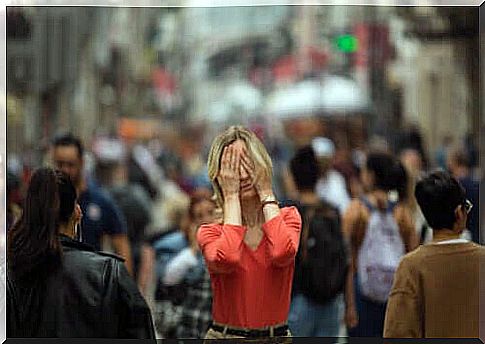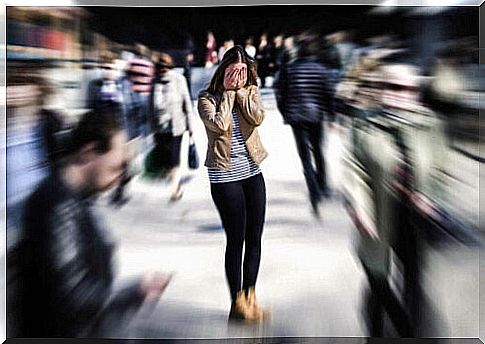What Are The Symptoms Of Agoraphobia?

Many different entities have taken on the task of describing the symptoms of agoraphobia. However, they have all found that it is a rather complex disease that each person can experience in different ways. If we were to classify it, we could classify it under anxiety disorders.
The people who suffer from it experience anxiety or excessive fear of places or situations where they feel helpless, trapped or embarrassed. It can include, for example, open areas, very crowded places and even public transportation.
The problem here is that the symptoms of agoraphobia vary widely and the phobias sometimes overlap. In this article we will explain the most frequent manifestations.
The symptoms of agoraphobia according to DSM-V
DSM-V is the American diagnostic and classification system for mental disorders, which was updated in 2013. It is the tool that psychologists and psychiatrists usually use to identify various diseases and disorders. According to this manual, the most common symptoms of agoraphobia are the following:
- Feeling anxious in places where it can be difficult or embarrassing to try to walk away. These people are usually afraid of suffering from an anxiety attack and of suffering from it in a place where they are unable to get any help, which is even worse. As a result, crowded places outside their homes cause them the most unrest. It can be public transport or supermarkets.
- This fear means that evasive behavior patterns often begin to develop. If a person experiences anxiety when riding a bus, then for example, they will avoid buses completely. They will change their habits for fear of having an anxiety attack on the bus.
- In order to be able to make a definitive diagnosis of agoraphobia , the anxiety attacks must be frequent or at least one of them must have caused intense worry or fear. By that, we mean that the person is afraid of suffering from another seizure, and changes his behavior from that moment on as a result of it.
At this point, we should emphasize that other mental disorders must be ruled out in order to make a correct diagnosis. The reason for this is that certain specific phobias such as social phobia often tend to be confused with agoraphobia.

Some examples of symptoms of agoraphobia
The symptoms of agoraphobia, as we have already mentioned, vary from person to person. The disorder often causes a fear of being in open areas, especially when one is alone. However, it can also occur in closed places such as in cinemas or in the theater.
Something else that is quite characteristic of agoraphobia is the fear of experiencing an embarrassing situation. The people are afraid of what would happen if they fell or had an anxiety attack in front of other people. This fear tends to be quite extreme and very intense.
The problem here is that all of this ends up affecting every single area of the person’s life. As we have already mentioned, evasive behaviors will begin to develop.
For example, if they are afraid to take public transportation to work or perform a leisure activity, then evasive behaviors will begin to condition how they act and react, and this will deter them from taking part in all sorts of activities.
Other considerations about agoraphobia
According to an article published in the journal Professional Pharmacy , symptoms of agoraphobia usually appear in late adolescence or early adulthood. Most of these people seek more and more refuge in their homes, where they only go out when they see it as necessary.
If this disease is not treated in time, then it ends up becoming chronic and nourishes itself, making it difficult to control. We must keep in mind that, after all, it is a panic disorder, and because of that, it is also accompanied by physical symptoms.
An article in the Journal of Psychopathology and Clinical Psychology explains that when a crisis arises, the heart rate increases and the person may experience a feeling of being suffocated. Sweating increases and there is discomfort and pressure in the chest area.
In extreme cases, it can lead to dizziness and fainting. The anxiety experienced makes the person feel that they have lost control. It can also produce a fear of dying.

What to remember about this disorder and its symptoms
What we need to keep in mind is that agoraphobia is a complex disorder that can manifest itself in many different ways. These people are afraid of specific situations such as using public transport or going to places where they feel they will not get help if a crisis arises.
Because of this, it is essential that they receive the appropriate psychological support and treatment. If not, then the disorder can become chronic and end up defining and controlling the lives of these people. It keeps them from performing their normal daily routines.









